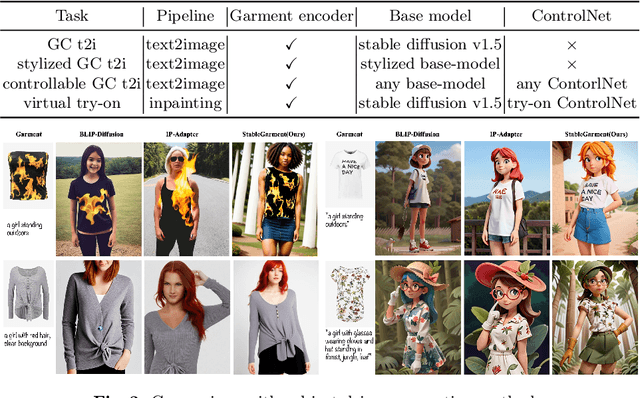Hailong Guo
PhotoDoodle: Learning Artistic Image Editing from Few-Shot Pairwise Data
Feb 23, 2025Abstract:We introduce PhotoDoodle, a novel image editing framework designed to facilitate photo doodling by enabling artists to overlay decorative elements onto photographs. Photo doodling is challenging because the inserted elements must appear seamlessly integrated with the background, requiring realistic blending, perspective alignment, and contextual coherence. Additionally, the background must be preserved without distortion, and the artist's unique style must be captured efficiently from limited training data. These requirements are not addressed by previous methods that primarily focus on global style transfer or regional inpainting. The proposed method, PhotoDoodle, employs a two-stage training strategy. Initially, we train a general-purpose image editing model, OmniEditor, using large-scale data. Subsequently, we fine-tune this model with EditLoRA using a small, artist-curated dataset of before-and-after image pairs to capture distinct editing styles and techniques. To enhance consistency in the generated results, we introduce a positional encoding reuse mechanism. Additionally, we release a PhotoDoodle dataset featuring six high-quality styles. Extensive experiments demonstrate the advanced performance and robustness of our method in customized image editing, opening new possibilities for artistic creation.
Any2AnyTryon: Leveraging Adaptive Position Embeddings for Versatile Virtual Clothing Tasks
Jan 27, 2025Abstract:Image-based virtual try-on (VTON) aims to generate a virtual try-on result by transferring an input garment onto a target person's image. However, the scarcity of paired garment-model data makes it challenging for existing methods to achieve high generalization and quality in VTON. Also, it limits the ability to generate mask-free try-ons. To tackle the data scarcity problem, approaches such as Stable Garment and MMTryon use a synthetic data strategy, effectively increasing the amount of paired data on the model side. However, existing methods are typically limited to performing specific try-on tasks and lack user-friendliness. To enhance the generalization and controllability of VTON generation, we propose Any2AnyTryon, which can generate try-on results based on different textual instructions and model garment images to meet various needs, eliminating the reliance on masks, poses, or other conditions. Specifically, we first construct the virtual try-on dataset LAION-Garment, the largest known open-source garment try-on dataset. Then, we introduce adaptive position embedding, which enables the model to generate satisfactory outfitted model images or garment images based on input images of different sizes and categories, significantly enhancing the generalization and controllability of VTON generation. In our experiments, we demonstrate the effectiveness of our Any2AnyTryon and compare it with existing methods. The results show that Any2AnyTryon enables flexible, controllable, and high-quality image-based virtual try-on generation.https://logn-2024.github.io/Any2anyTryonProjectPage/
StableGarment: Garment-Centric Generation via Stable Diffusion
Mar 16, 2024



Abstract:In this paper, we introduce StableGarment, a unified framework to tackle garment-centric(GC) generation tasks, including GC text-to-image, controllable GC text-to-image, stylized GC text-to-image, and robust virtual try-on. The main challenge lies in retaining the intricate textures of the garment while maintaining the flexibility of pre-trained Stable Diffusion. Our solution involves the development of a garment encoder, a trainable copy of the denoising UNet equipped with additive self-attention (ASA) layers. These ASA layers are specifically devised to transfer detailed garment textures, also facilitating the integration of stylized base models for the creation of stylized images. Furthermore, the incorporation of a dedicated try-on ControlNet enables StableGarment to execute virtual try-on tasks with precision. We also build a novel data engine that produces high-quality synthesized data to preserve the model's ability to follow prompts. Extensive experiments demonstrate that our approach delivers state-of-the-art (SOTA) results among existing virtual try-on methods and exhibits high flexibility with broad potential applications in various garment-centric image generation.
Temporal Difference Learning for High-Dimensional PIDEs with Jumps
Jul 06, 2023



Abstract:In this paper, we propose a deep learning framework for solving high-dimensional partial integro-differential equations (PIDEs) based on the temporal difference learning. We introduce a set of Levy processes and construct a corresponding reinforcement learning model. To simulate the entire process, we use deep neural networks to represent the solutions and non-local terms of the equations. Subsequently, we train the networks using the temporal difference error, termination condition, and properties of the non-local terms as the loss function. The relative error of the method reaches O(10^{-3}) in 100-dimensional experiments and O(10^{-4}) in one-dimensional pure jump problems. Additionally, our method demonstrates the advantages of low computational cost and robustness, making it well-suited for addressing problems with different forms and intensities of jumps.
 Add to Chrome
Add to Chrome Add to Firefox
Add to Firefox Add to Edge
Add to Edge